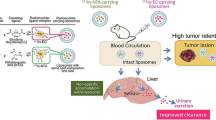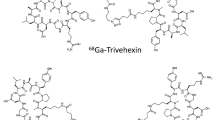Abstract
People drink various types of tea without knowing the side effects of biological and chemical contents and radiopharmaceutical interactions. In current study, it is aimed to evaluate the effects of green tea extract in different extraction solvents on the radiolabeling of the blood constituents with 99mTc and on the biodistribution of radiopharmaceutical sodium pertechnetate (Na99mTcO4) in male Wistar Albino rats. The extraction of green tea was performed in different solvents. Biodistribution studies were performed on male rats which were treated via gavage with green tea extract in different extraction solvents or saline (0.9 % NaCl) as a control group for 7 days. The radiolabeling of blood constituents performed incubating with SnCl2 and 99mTc. According to experimental results, radiolabeling blood components with 99mTc were not modified in the usage of the different extraction solvents for green tea extraction, but a significant alteration (P < 0.05) of biodistribution of Na99mTcO4 was observed after treatment with green tea extract in distilled water. Although there is no considerable effect on radiolabeling of blood components, there is an outstanding change on the biodistribution studies especially with green tea extract in distilled water. The identified change monitored in this study may cause to reduce the risk of misdiagnosis and/or avoid the repetition of the examinations in nuclear medicine.


Similar content being viewed by others
References
Grove KA, Lambert JD (2010) Laboratory, epidemiological, and human intervention studies show that tea (Camellia sinensis) may be useful in the prevention of obesity. J Nutr 140:446–453
Khokhar S, Magnusdottir SGM (2002) Total phenol, catechin, and caffeine contents of teas commonly consumed in the United Kingdom. J Agric Food Chem 50:565–570
Zhang M, Li L, Liu P, Holman CDAJ (2012) Green tea for the prevention of cancer : evidence of field epidemiology. Funct Foods Heal Dis 2:339–349
Li S, Lo C-Y, Pan M-H, Lai C-S, Ho C-T (2013) Black tea: chemical analysis and stability. Food Funct 4:10–18
Johnson R, Bryant S, Huntley AL (2012) Green tea and green tea catechin extracts: an overview of the clinical evidence. Maturitas 73:280–287
Cabrera C, Artacho R, Gimenez R (2006) Beneficial effects of green tea: a review. J Am Coll Nutr 25:79–99
McQuade KJ, Nakajima A, Ilacqua AN, Shimda N, Sawai S (2013) The green tea catechin epigallocatechin gallate (EGCG) blocks cell motility, chemotaxis and development in Dictyostelium discoideum. PLoS One 8(e59275):1–13
Sturgeon JL, Williams M, van Servellen G (2009) Efficacy of green tea in the prevention of cancers. Nurs Health Sci 11:436–446
Lambert JD, Hong J, Yang G-Y, Liao J, Yang C-S (2005) Inhibition of carcinogenesis by polyphenols: evidence from laboratory investigations. Am J Clin Nutr 81:284S–291S
Gomes ML, de Oliveira MBN, Bernardo-Filho M (2002) Drug interaction with radiopharmaceuticals: effect on the labeling of red blood cells with technetium-99m and on the bioavailability of radiopharmaceuticals. Brazilian Arch Biol Technol 45:143–149
Moreno SRFRF, Silva ALCLC, Diré G, Honeycut H, Carvalho JJJ, Nascimento ALL, Pereira M, Rocha EKK, Oliveira-Timóteo M, Arnobio A, Olej B, Bernardo-Filho M, Caldas LQAQA (2007) Effect of oral ingestion of an extract of the herb Uncaria tomentosa on the biodistribution of sodium pertechnetate in rats. Brazilian J Med Biol Res 40:77–80
Valenca SS, Lima EA, Dire GF, Bernardo-Filho MP, Luís C (2005) Sodium pertechnetate (Na99mTcO4) biodistribution in mice exposed to cigarette smoke. BMC Nucl Med 5:1–5
Braga ACS, Gomes ML, Santos S, De Fonseca J, Machado EF, Oliveira MP, Santos-Sebastião D, Bernardo-Filho M (2012) Alteration of the labeling of blood constituents with technetium-99m and the morphology of red blood cells by Baccharis trimera extract. Afr J Pharm Pharmacol 6:228–234
Niemeyer MG, van der Wall EE, Kuijper AF, Cleophas AT, Pauwels EK (1995) Nuclear cardiology, current applications in clinical practice. Angiology 46:591–602
Wong KT, Beauvais MM, Melchior WR, Snyder SP (2004) Enhanced liver uptake of Tc-99m-labeled RBCs during gastrointestinal bleed scintigraphy using transfused RBCs compared with autologous RBCs. Clin Nucl Med 29:522–523
Rebello BM, Moreno SRF, Godinho CR, Neves RF, Fonseca AS, Bernardo-Filho M (2008) Effects of Passiflora edulis flavicarpa on the radiolabeling of blood constituents, morphology of red blood cells and on the biodistribution of sodium pertechnetate in rats. Appl Radiat Isot 66:1788–1792
Cekic B, Biber Muftuler FZ, Yurt AK, Ichedef C, Unak P (2011) Effects of broccoli extract on biodistribution and labeling blood components with 99mTc-GH. Acta Cirúrgica Bras 26:339–345
Rusak G, Komes D, Likić S, Horžić D, Kovač M (2008) Phenolic content and antioxidative capacity of green and white tea extracts depending on extraction conditions and the solvent used. Food Chem 110:852–858
Zora H, Muftuler ZFB, Demir I, Yurt Kilcar A, Ichedef C, Unak P (2012) Effect of a plant origin drug on the biodistribution of 99mTc-DTPA in Wistar albino rats. Brazilian J Pharmacogn 22:344–349
Santos-Filho SD, Maiworm AI, Presta GA, Paoli S, Giani TS, Bernardo-Filho M (2007) Aqueous extract of the medicinal plant Mentha crispa alters the biodistribution of the radiopharmaceutical sodium pertechnetate in Wistar rats. Med Chem Res 16:230–237
Moreno SRF, Carvalho JJ, Nascimento AL, Pereira M, Rocha EK, Diré G, Arnobio A, Caldas LQA, Bernardo-Filho M (2005) Bioavailability of the sodium pertechnetate and morphometry of organs isolated from rats: study of possible pharmacokinetic interactions of a ginkgo biloba extract. Brazilian Arch Biol Technol 48:73–78
Diré GF, Lima EAC, Gomes ML, Moreno S, Faria MVC, Jales RL (2003) Evaluation of the biological effects of a natural extract of Chayote (Sechium edule): a molecular and cellular analysis. Pakistan J Nutr 2:249–253
Janković DL, Djokić DD (2005) Alteration of the organ uptake of the (99m)Tc-radiopharmaceuticals, (99m)Tc-DPD, (99m)Tc-DMSA, (99m)Tc-tin colloid and (99m)Tc-MAA, induced by the applied cytotoxic drugs methotrexate sodium and cyclophosphamide. Nucl Med Commun 26:415–419
Kurahashi N, Sasazuki S, Iwasaki M, Inoue M, Tsugane S (2008) Green tea consumption and prostate cancer risk in Japanese men: a prospective study. Am J Epidemiol 167:71–77
de CX Holanda CM, Costa MB, Silva NCZ, Silva Júnior MF, Barbosa VSA (2009) Effect of an extract of Aloe vera on the biodistribution of sodium pertechnetate (Na99mTcO4) in rats. Acta Cir Bras 24:383–386
Sarma DN, Barrett ML, Chavez ML, Gardiner P, Ko R, Mahady GB, Marles RJ, Pellicore LS, Giancaspro GI, Low Dog T (2008) Safety of green tea extracts: a systematic review by the US Pharmacopeia. Drug Saf 31:469–484
Setiawan VW, Zhang ZF, Yu GP et al (2001) Protective effect of green tea on the risks of chronic gastritis and stomach cancer. Int J Cancer 92:600–604
Mu L-N, Lu Q-Y, Yu S-Z, Lu QY, Li YL, Lu ML, Wang MR, Guo CH, Yu SZ, Kurtz RC, Hsieh CC (2005) Green tea drinking and multigenetic index on the risk of stomach cancer in a Chinese population. Int J Cancer 116:972–983
Lima EAC, Diré G, Mattos DMM, Freitas RS, Gomes ML, de Oliveira MBN, Faria MVC, Jales RL, Bernardo-Filho M (2002) Effect of an extract of cauliflower (leaf) on the labeling of blood elements with technetium-99m and on the survival of Escherichia coli AB1157 submitted to the treatment with stannous chloride. Food Chem Toxicol 40:919–923
Dire G, Lima E, Gomes MB-FM (2003) The effect of a chayote (Sechium edule) extracts (Decoct and Macerated) on the labeling of blood elements with technetium-99m and on the biodistribution of the radiopharmaceutical sodium pertechnetate in mice: an in vitro and in vivo analysis. Pakistan J Nutr 2:221–227
Author information
Authors and Affiliations
Corresponding author
Rights and permissions
About this article
Cite this article
Sabuncu, B., Biber Muftuler, F.Z., Yurt Kilcar, A. et al. Interaction between green tea extract and 99mTc-pertechnetate on in vivo distribution. J Radioanal Nucl Chem 300, 1021–1026 (2014). https://doi.org/10.1007/s10967-014-3089-y
Received:
Published:
Issue Date:
DOI: https://doi.org/10.1007/s10967-014-3089-y




